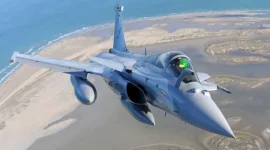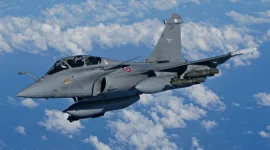- Views: 4K
- Replies: 45

The Indian Navy is poised for a significant upgrade in its anti-ship capabilities with the impending induction of Rafale M (Marine) fighter jets. Equipped with two cutting-edge anti-ship missile systems, the NASM-MR and BrahMos-NG, these aircraft will substantially enhance India's ability to neutralize hostile warships in the Indian Ocean Region (IOR).
The NASM-MR (Medium Range Anti-Ship Missile), currently under development by DRDO, is an all-weather, over-the-horizon cruise missile. Designed for precision strikes, stealth, and extended reach, the NASM-MR will allow the Navy to engage enemy ships at distances up to 300 kilometers. This stand-off range places Rafale M pilots beyond the reach of most enemy ship defenses, increasing survivability and ensuring potent strike capabilities.
The missile's advanced guidance systems and reduced radar cross-section make it difficult to detect and intercept. The NASM-MR is intended for deployment on various Indian naval platforms, providing flexibility for both ship-borne and airborne launches.
Complementing the NASM-MR is the BrahMos-NG (Next Generation) missile, a miniaturized version of the BrahMos supersonic cruise missile developed by BrahMos Aerospace. Reaching speeds of Mach 3.5, the BrahMos-NG offers India the capability to launch high-speed attacks on enemy vessels. This velocity makes it extremely challenging for adversaries to intercept the missile with conventional anti-missile systems.
Despite its power, the BrahMos-NG is designed to be smaller and lighter than its predecessor, allowing the Rafale M to carry it without compromising aerodynamics or payload. With a range of 290 km, the BrahMos-NG can strike targets deep within enemy territory, keeping the Rafale M safely out of range while delivering devastating blows.
Both the NASM-MR and BrahMos-NG offer long-range attack capabilities, enabling the Indian Navy to strike swiftly and decisively without jeopardizing its valuable assets. This advantage is crucial for maintaining control over vital sea lanes and maritime chokepoints. The extended reach of these missiles allows the Navy to target hostile vessels long before they pose a threat to Indian assets, creating critical buffer zones around the Indian coastline and maritime borders.
Furthermore, both missiles are equipped with advanced targeting systems to ensure precision strikes and minimize collateral damage. The stealth features of the NASM-MR and the high speed of the BrahMos-NG make them incredibly difficult for enemy radar and missile defence systems to track and intercept. This combination of capabilities poses a significant challenge even to the most sophisticated ship defenses.
The versatility of the NASM-MR and BrahMos-NG allows them to be adapted for various mission profiles, from coastal defence to open-ocean engagements. This adaptability provides the Indian Navy with the flexibility to deploy Rafale M fighters in a wide range of offensive and defensive roles, ensuring operational readiness across diverse scenarios.


